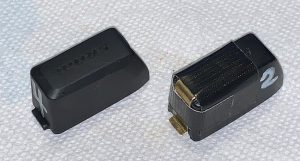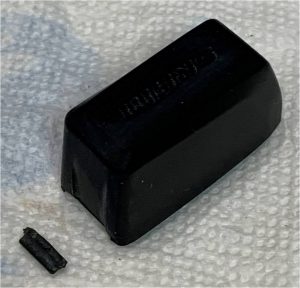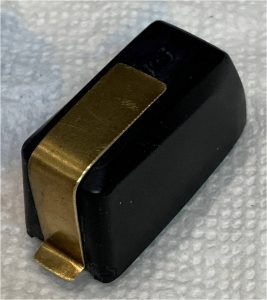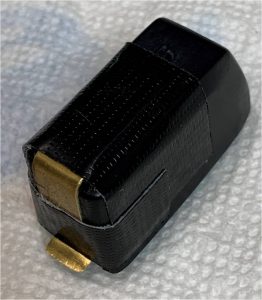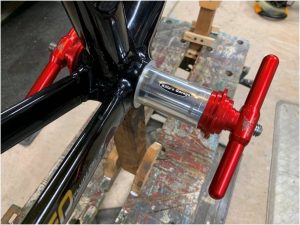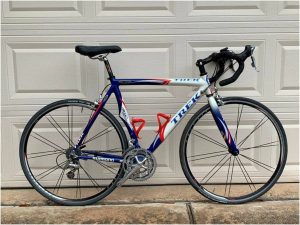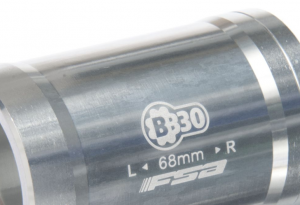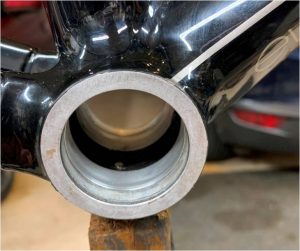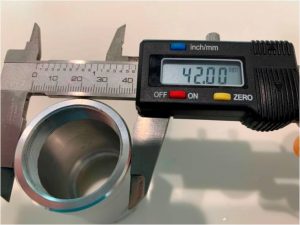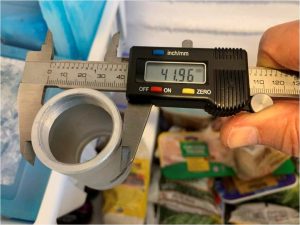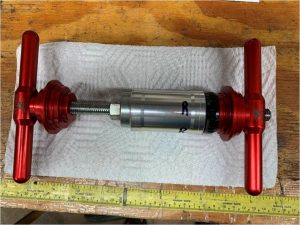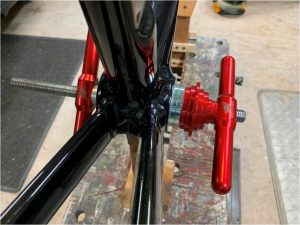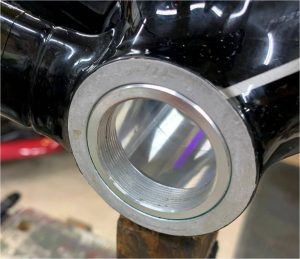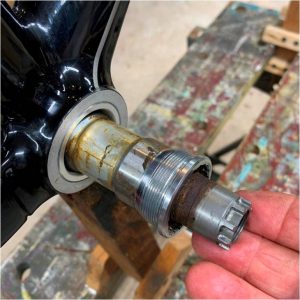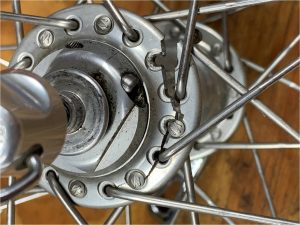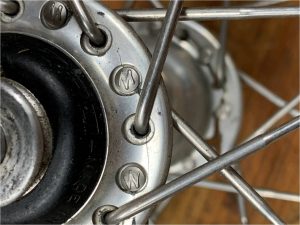If you are ever offered the opportunity to work on an extra large time trial bike with an internally routed rear hydraulic rim brake below the bottom bracket, turn around slowly and run like hell!
I’m joking; it was a great experience but it was challenging, and by the time I finished I knew I’d write a post about it.
My friend (Let’s call him Flywheel), brought me his bike for some service.
This bike is a slippery speed machine. Everything is internal or shrouded. It’s quite aerodynamic. But this design is less than ideal when it comes to service and repair.
Among a few other relatively easy tweaks, the bike had a frozen rear brake. As the brake caliper was located below the bottom bracket I can’t say I was surprised. If you’ve been reading my blog you know how I feel about brakes under the bottom bracket. And Flywheel is a big guy, over six feet tall and solid, so good brakes are important for him. At least here in the Houston area we don’t have any serious downhills.
I think I’ll organize this conversation in reverse order – “A below the bottom bracket hydraulic rim brake that is internally routed on a time trial bike, size extra large”.
1. Brake mounted below the bottom bracket:
Here’s a picture taken after reconstruction, nice and clean!
This is just a bad idea! Hey, let’s put a piece of safety critical equipment under the bottom bracket – the dirtiest place on the bike.
At least on this bike there was a shroud covering the brake, though this was for aerodynamic effect and was obviously ineffective at protecting the brake from water and debris ingress.
I think this is an interface problem. The brake manufacturer makes some assumptions about the location and orientation of the caliper on the bike. For instance, on another bike I serviced, the caliper return spring is located in a pocket that effectively forms an upward-facing cup when mounted below the bottom bracket. Put that brake on the seatstays or fork and the pocket easily sheds debris and water. Below the bottom bracket it collects them! I think that if they were designing a brake for mounting below the bottom bracket, they would build it differently.
On Flywheel’s bike, there are no upward facing cups, but there are unsealed thrust bearings on the pivot studs each containing ten 1/16” balls. Upon disassembly I found forty rusty little lumps of steel.
I replaced the bearings and restored the mechanical function of the brake. What does it mean: “Do not disassemble; no user-serviceable parts inside”?
And here’s a picture of a fully functional thrust bearing of the same design from a ten year old Campy Record fork-mounted front brake. These bearings can last in the right environment.
Now you’re wondering how I came to be disassembling a Campy Record fork-mounted front brake. Well, the return spring broke, but that’s a subject for another post.
After restoring mechanical function, it was time to bleed the brakes. The hydraulic access port on the caliper faces down, of course. So flip the bike upside down to attach the syringe to the caliper, flip it back to attach the bleed syringe to the lever, bleed but watch for air bubbles which are trying to rise into the caliper because the caliper port is facing down now, flip the bike back upside down to detach the syringe at the caliper and cap the caliper port. Flip the bike upside right, detach the lever syringe and cap the lever port. This all would not be so difficult if there was any way to clamp the bike in a pivoting workstand, but there isn’t. (Is there?)
Anyway, I got the brake bled and restored hydraulic function, but that proved to be short-lived for reasons as yet unknown. I hope Flywheel lets me work on it some more.
2. Hydraulic Rim Brakes
OK, on hydraulic rim brakes the pads are farther away from the hydraulics and therefore less likely to get fluid-contaminated. That’s about the only benefit I can name for hydraulic rim brakes.
Hydraulic disc brakes eliminate the (flexible) lever arms and cable friction. The hydraulic rim brakes on this bike do eliminate the cable friction, but they leave a rather Rube Goldberg mechanical system in place. Watch this one minute video of the brake in action.
SRAM hydraulic rim brakes at least employ a simpler, probably stiffer, mechanical system.
SRAM Red HRR brake caliper – note the adjuster barrel and release tab. It looks very much like a mechanical rim brake. You can even see the end of the return spring sticking out from behind the left arm.
Hydraulic disc brakes self-adjust for pad wear. Hydraulic rim brakes don’t.
Also, hydraulic disc brakes eliminate the need for return springs. The minute amount of piston retraction in a disc brake is courtesy of piston seal elasticity. Hydraulic rim brakes require a much larger range of motion, the same as mechanical rim brakes, so return springs are still required.
I just don’t see a compelling need for the addition of hydraulics to a rim brake system. I think fitting rim brakes with hydraulics was a step in the long range conspiracy …I mean plan… to introduce disc brakes to road cycling.
To reference an imperfect analogy, we have moved past hydraulic rim brakes the way we moved past CFL lighting. Man, wouldn’t you hate to have been the owner of a CFL factory when LED lights came out.
Anybody remember HID bicycle headlights?
3. Internal Routing
As a mechanic, internal routing just makes everything harder, with hydraulic systems doubly so. Aside from the normal difficulties of tracing and fishing cables through a frame, doing so usually requires cutting off the “olive” terminations and fitting new ones, a much more tedious and error-prone operation than routing standard brake cables.
At least this bike, being ETAP-equipped, did not have shifter cabling all over. (There was a bit of wiring in the cockpit; blips on the bar-ends wired to a shifter unit on the stem, all internally wired of course.)
It’s a shame that all the cockpit wiring is so neatly tucked away except the last bit to the button box.
4. Time Trial Bike
I really have nothing much against time trial bikes. I don’t own one and I don’t want one, but that’s just me. My only complaint as it relates to this post is those cute little aero brake levers with their limited travel. They never work very well, and I think there a few flaws in the design of these specific levers, but that’s beyond today’s scope. And that’s all I have to say about that.
5. Extra Large Bike
I eventually got everything sorted, put on the wheels, and realized I couldn’t even straddle the top tube, or reach the pedals from the saddle, even with the saddle all the way down. I had to test-ride the bike standing in front of the saddle! That’s a picture I’m glad I don’t have. Hey mechanics, how do you road test a bike that is too big to ride?
Tailwinds
Killa
PS: Sorry if I sound annoyed. I’m not. Really. I enjoy this stuff. I promise not to rant so much in my next post.
